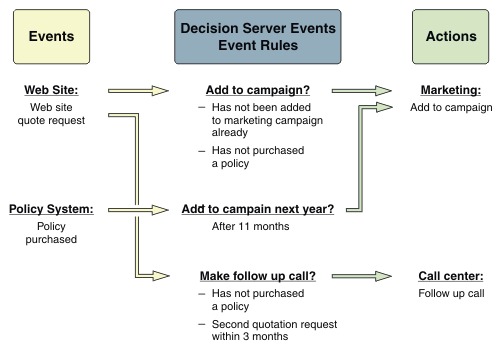Tutorial: Getting started with event rules
This tutorial shows you how to build a small application around the scenario of an insurance company that is identifying business opportunities by using business event processing.
Scenario
An insurance company wants to improve its ability to identify potential customers and close sales that might otherwise be lost. The company sells a range of insurance products, but this tutorial focuses on identifying potential car insurance customers. The insurance company has a strong online presence. Most of the requests for quotations that come directly from potential customers (rather than through brokers or agents), come through the company website.
When an individual requests a quotation for car insurance using the company website, the request comes to the company quotation system. The quotation system responds by displaying a quotation on the website. A follow-up email is also sent to confirm the quotation, which is then valid for up to 90 days (12 weeks).
When the quotation request arrives via the website, it is also sent to Decision Server Events. A large number of quotation requests are received every day. It is too expensive to follow up every quotation with a telephone call. The company want to identify when a quotation request is most likely to lead to a sale. In this situation the potential customer receives a personal call from the company call center.
For example, the company believe that a potential customer shows that they are more seriously looking to buy a car insurance policy when they request more than one quotation for car insurance, from the company in a short time period (for example, altering the options selected on the policy). The insurance company wants to add the potential customer to a relevant marketing campaign.
Because the insurance company does not want to annoy customers, it is important that the potential customer does not receive a sales call from the call center if they have already purchased a policy from the company. It is also important that the customer is not added to marketing campaigns multiple times, if they later request a second or third quotation from the company.
Before you start the tutorial
- Install Decision Server Events by using the
IBM®
Installation Manager and then selecting the Event Tester
Enabler feature during the installation. See Operational
Decision Manager license. The Event Tester Enabler feature is not selected by default during
the installation, but is required to perform this tutorial. By default, the IBM
Installation Manager installs Event Designer, the event runtime, and the Event
Widgets for Decision Server.Important: If you previously installed Decision Server Events and there is an existing sample server profile on your system, you must remove the older profile and create a new profile to enable the Event Tester. See Restoring the sample server.
- Click Getting_Started_with_Events.zip to download this zip file to your computer and extract it to a directory on your computer. The Getting_Started_with_Events.zip file contains a completed version of the tutorial application.
Tutorial exercises
The first exercise in this tutorial focuses on building an application that adds potential customers to marketing campaigns, when they request a quotation for car insurance. Subsequent exercises increase the capability of the application by adding further logic to identify when a customer has requested more than one quotation for car insurance in a specific time period.
Each exercise introduces new features of Decision Server Events as they become relevant to the application you are building.
- IT user - defines the data model (the structure of the events and actions) and the connections to other systems
- Business user - defines the business logic by using the assets that the IT user has previously defined
The following diagram illustrates the scenario used in the tutorial.
